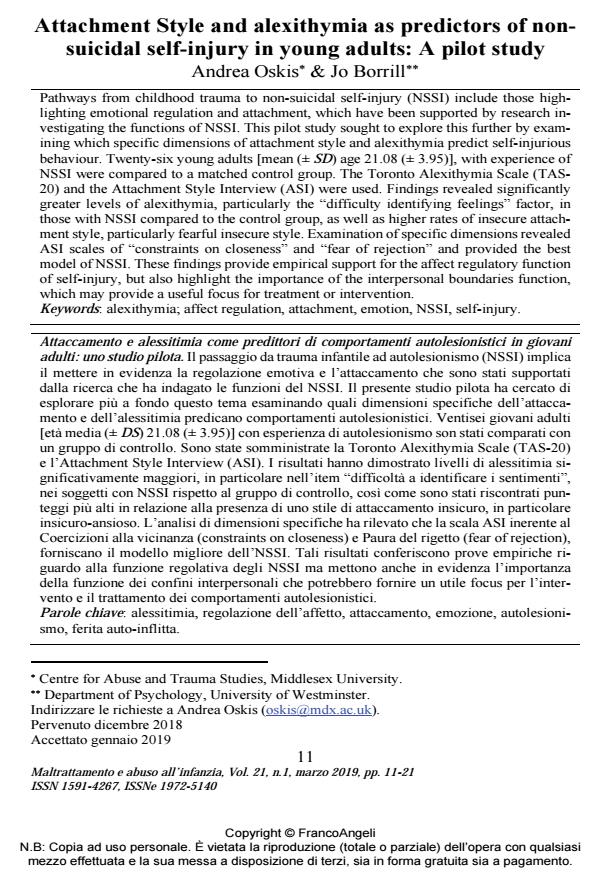Attachment Style and alexithymia as predictors of nonsuicidal self-injury in young adults: A pilot study
Journal title MALTRATTAMENTO E ABUSO ALL’INFANZIA
Author/s Andrea Oskis, Jo Borrill
Publishing Year 2019 Issue 2019/1
Language English Pages 11 P. 11-21 File size 382 KB
DOI 10.3280/MAL2019-001002
DOI is like a bar code for intellectual property: to have more infomation
click here
Below, you can see the article first page
If you want to buy this article in PDF format, you can do it, following the instructions to buy download credits

FrancoAngeli is member of Publishers International Linking Association, Inc (PILA), a not-for-profit association which run the CrossRef service enabling links to and from online scholarly content.
Pathways from childhood trauma to non-suicidal self-injury (NSSI) include those high-lighting emotional regulation and attachment, which have been supported by research inves-tigating the functions of NSSI. This pilot study sought to explore this further by examining which specific dimensions of attachment style and alexithymia predict self-injurious behav-iour. Twenty-six young adults [mean (± SD) age 21.08 (± 3.95)], with experience of NSSI were compared to a matched control group. The Toronto Alexithymia Scale (TAS-20) and the Attachment Style Interview (ASI) were used. Findings revealed significantly greater levels of alexithymia, particularly the "difficulty identifying feelings" factor, in those with NSSI compared to the control group, as well as higher rates of insecure attachment style, particularly fearful insecure style. Examination of specific dimensions revealed ASI scales of "constraints on closeness" and "fear of rejection" and provided the best model of NSSI. These findings provide empirical support for the affect regulatory function of self-injury, but also highlight the importance of the interpersonal boundaries function, which may pro-vide a useful focus for treatment or intervention.
Keywords: Alexithymia; affect regulation, attachment, emotion, NSSI, self-injury.
- Fisher, H. L., & Hosang, G. M. (2010). Childhood maltreatment and bipolar disorder: A critical review of the evidence. Mind Brain, 1(1), 75-85.
- Fliege, H., Lee, J., Grimm, A., & Klapp, B. F. (2009). Risk factors and correlates of deliberate self-harm behavior: A systematic review. Journal of Psychosomatic Research, 66(6), 477-493.
- Foster, T., Gillespie, K., McClelland, R., & Patterson, C. (1999). Risk factors for suicide independent of DSM-III-R Axis I disorder. Case-control psychological autopsy study in Northern Ireland. British Journal of Psychiatry, 175, 175-179.
- Gaher, R. M., Hofman, N. L., Simons, J. S., & Hunsaker, R. (2013). Emotion regulation deficits as mediators between trauma exposure and borderline symptoms. Cognitive therapy and research, 37(3), 466-475.
- Gratz, K. (2001). Measurement of Deliberate Self-Harm: Preliminary Data on the Deliberate Self-Harm Inventory. Journal of Psychopathology and Behavioral Assessment, 23(4), 253-263. DOI: 10.1023/A:1012779403943
- Hosang, G. M., Korszun, A., Jones, L., Jones, I., Gray, J. M., Gunasinghe, C. M., McGuffin, P., & Farmer, A. E. (2010). Adverse life event reporting and worst illness episodes in unipolar and bipolar affective disorders: Measuring environmental risk for genetic research. Psychological Medicine, 40(11), 1829-1837. DOI: 10.1017/S003329170999225X
- Howard, R., Karatzias, T., Power, K., & Mahoney, A. (2017). From childhood trauma to self‐harm: An investigation of theoretical pathways among female prisoners. Clinical Psychology & Psychotherapy, 24(4), 942-951.
- Klonsky, E. D. (2007). The functions of deliberate self-injury: A review of the evidence. Clinical Psychology Review, 27(2), 226-239.
- Lambert, A., & de Man, A. F. (2007). Alexithymia, Depression, and Self-Mutilation in Adolescent Girls. North American Journal of Psychology, 9(3), 555-566.
- Mikulincer, M., & Shaver, P. R. (2012). An attachment perspective on psychopathology. World Psychiatry, 11(1), 11-15.
- Nock, M. K. (2010) Self-injury. Annual Review of Clinical Psychology, 6, 1-25.
- Oskis, A., Clow, A., Hucklebridge, F., Bifulco, A., Jacobs, C., & Loveday, C. (2013). Understanding alexithymia in female adolescents: The role of attachment style. Personality and Individual Differences, 54(1), 97-102.
- Spence, R., Bunn, A., Nunn, S., Hosang, G. M., Kagan, L., Fisher, H. L., Taylor, M., & Bifulco, A. (2015). Measuring life events and their association with clinical disorder: a protocol for development of an online approach. JMIR Research Protocols, 4(3).
- Taylor, G. J., Parker, J. D. A., & Bagby, R. M. (1992). Toronto Alexithymia Scale-20. Toronto: Department of Psychiatry, Mount Sinai Hospital.
- Bifulco, A., Moran, P. M., Ball, C., & Bernazzani, O. (2002). Adult attachment style, I: Its relationship to clinical depression. Social Psychiatry and Psychiatric Epidemiology, 37(2), 50-59.
- Bifulco, A., Schimmenti, A., Moran, P., Jacobs, C., Bunn, A., & Rusu, A. (2014). Problem parental care, and teenage deliberate self-harm in young community adults. Journal of the Menninger Bulletin, 78(2), 95-114.
- Borrill, J., Fox, P., Flynn, M., & Roger, D. (2009). Students who self-harm: Coping style, Rumination and Alexithymia. Counselling Psychology Quarterly, 22(4), 361-372. DOI: 10.1080/09515070903334607
- Briere, J., & Gil, E. (1998). Self-mutilation in clinical and general population samples: Prevalence, correlates, and functions. American Journal of Orthopsychiatry, 68(4), 609-620.
- Carroll, R., Metcalfe, C., & Gunnell, D. (2014). Hospital presenting self-harm and risk of fatal and non-fatal repetition: Systematic review and meta-analysis. PLoS One, 9(2), p.e89944.
- Yates, T. M. (2009). Developmental pathways from child maltreatment to nonsuicidal self-injury. In M. K. Nock (Ed.), Understanding nonsuicidal self-injury: Origins, assessment, and treatment (pp. 117-137). Washington, DC: American Psychological Association.
- Zigmond, A. S., & Snaith, R. P. (1983). The Hospital Anxiety and Depression Scale. Acta Psychiatrica Scandinavica, 67, 361-370.
- The relationship between self‐harm and alexithymia: A systematic review and meta‐analysis Hilary Norman, Andrea Oskis, Lisa Marzano, Mark Coulson, in Scandinavian Journal of Psychology /2020 pp.855
DOI: 10.1111/sjop.12668
Andrea Oskis, Jo Borrill, Attachment Style and alexithymia as predictors of nonsuicidal self-injury in young adults: A pilot study in "MALTRATTAMENTO E ABUSO ALL’INFANZIA" 1/2019, pp 11-21, DOI: 10.3280/MAL2019-001002